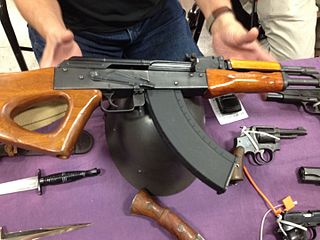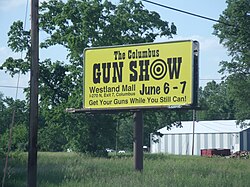
The National Firearms Act (NFA), 73rd Congress, Sess. 2, ch. 757, 48 Stat. 1236 was enacted on June 26, 1934, and currently codified and amended as I.R.C. ch. 53. The law is an Act of Congress in the United States that, in general, imposes an excise tax on the manufacture and transfer of certain firearms and mandates the registration of those firearms. The NFA is also referred to as Title II of the federal firearms laws, with the Gun Control Act of 1968 ("GCA") as Title I.

The Gun Control Act of 1968 is a U.S. federal law that regulates the firearms industry and firearms ownership. Due to constitutional limitations, the Act is primarily based on regulating interstate commerce in firearms by generally prohibiting interstate firearms transfers except by manufacturers, dealers and importers licensed under a scheme set up under the Act.

The Bureau of Alcohol, Tobacco, Firearms and Explosives (BATFE), commonly referred to as the ATF, is a domestic law enforcement agency within the United States Department of Justice. Its responsibilities include the investigation and prevention of federal offenses involving the unlawful use, manufacture, and possession of firearms and explosives; acts of arson and bombings; and illegal trafficking and tax evasion of alcohol and tobacco products. The ATF also regulates via licensing the sale, possession, and transportation of firearms, ammunition, and explosives in interstate commerce. Many of the ATF's activities are carried out in conjunction with task forces made up of state and local law enforcement officers, such as Project Safe Neighborhoods. The ATF operates a unique fire research laboratory in Beltsville, Maryland, where full-scale mock-ups of criminal arson can be reconstructed. The ATF had 5,285 employees and an annual budget of almost $1.5 billion in 2021. The ATF has received criticism over its handling of the Ruby Ridge siege, the Waco siege and other incidents.
A Federal Firearms License (FFL) is a license in the United States that enables an individual or a company to engage in a business pertaining to the manufacture or importation of firearms and ammunition, or the interstate and intrastate sale of firearms. Holding an FFL to engage in certain such activities has been a legal requirement within the United States since the enactment of the Gun Control Act of 1968. The FFL is issued by the Bureau of Alcohol, Tobacco, Firearms, and Explosives

A Firearms Transaction Record, or ATF Form 4473, is a seven-page form prescribed by the Bureau of Alcohol, Tobacco, Firearms and Explosives (ATF) required to be completed when a person proposes to purchase a firearm from a Federal Firearms License (FFL) holder, such as a gun dealer.

The National Instant Criminal Background Check System (NICS) is a background check system in the United States created by the Brady Handgun Violence Prevention Act of 1993 to prevent firearm sales to people prohibited under the Act. The system was launched by the Federal Bureau of Investigation (FBI) in 1998. Under the system, firearm dealers, manufacturers or importers who hold a Federal Firearms License (FFL) are required to undertake a NICS background check on prospective buyers before transferring a firearm. The NICS is not intended to be a gun registry, but is a list of persons prohibited from owning or possessing a firearm. By law, upon successfully passing the background check, the buyer's details are to be discarded and a record on NICS of the firearm purchase is not to be made. However as an FFL holder, the seller is required to keep a record of the transaction.

Gun show loophole, also called the private sale exemption, is the lack of mandatory background checks in the United States for private sales of firearms, including those done at gun shows. Under U.S. federal gun law, any person may sell a firearm to a federally unlicensed resident of the state where they reside, as long as they do not know or have cause to believe that the person is prohibited from possessing firearms, and as long as the seller is not "engaged in the business" of selling firearms.
The Youth Crime Gun Interdiction Initiative (YCGII) was led by the Bureau of Alcohol, Tobacco, Firearms and Explosives (ATF) during the late-1990s. The program aimed to increase firearm tracing of firearms recovered by law enforcement agencies, learn more about how juveniles and youth obtain firearms, and develop strategies to deal with problems involving illegally obtained firearms.
In the United States, the right to keep and bear arms is modulated by a variety of state and federal statutes. These laws generally regulate the manufacture, trade, possession, transfer, record keeping, transport, and destruction of firearms, ammunition, and firearms accessories. They are enforced by state, local and the federal agencies which include the Bureau of Alcohol, Tobacco, Firearms and Explosives (ATF).

Title II weapons, or NFA firearms, are designations of certain weapons under the United States National Firearms Act (NFA).

Report of Multiple Sale or Other Disposition of Pistols and Revolvers, or ATF Form 3310.4, is a form prescribed by the Bureau of Alcohol, Tobacco, Firearms, and Explosives (ATF) for use by firearm dealers holding a Federal Firearms License (FFL) to report when an unlicensed person purchases or acquires two or more handguns at one time or during five consecutive business days.
Project Gunrunner is a project of the U.S. Bureau of Alcohol, Tobacco, Firearms and Explosives (ATF) intended to stem the flow of firearms into Mexico, in an attempt to deprive the Mexican drug cartels of weapons.

eTrace is an Internet-based firearm trace request submission system, developed by the United States' federal government, Bureau of Alcohol, Tobacco, Firearms and Explosives, that provides for the electronic exchange of traced firearm data in a secure internet-based environment. Participating law enforcement agencies with access to the internet can acquire 24/7 real-time capabilities to electronically submit firearm trace requests, monitor the progress of traces, retrieve completed trace results, and to query firearm trace related data in Bureau of Alcohol, Tobacco, Firearms and Explosives (ATF) firearms registration database at the National Tracing Center. Firearms tracing is the systematic tracking of the movement of a firearm from its creation by the manufacturer or its introduction into U.S. commerce by the importer, through the distribution chain to the first retail purchase. Release 4.0, a bilingual version of eTrace was deployed in December, 2009 for the benefit of Spanish-speaking countries.
The National Tracing Center (NTC) of the Bureau of Alcohol, Tobacco, Firearms and Explosives (ATF) is the sole firearms tracing facility in the United States. It provides information to provide foreign (international), federal, state and local law enforcement agencies with suspects for firearm crime investigations, detect suspected firearms traffickers, and track the intrastate, interstate and international movement of firearms. Congressional restrictions are in place to prevent the release of firearms trace information to anyone other than law enforcement agencies, however, this restriction does not apply to participating foreign countries or agencies. The only restriction is by Memorandum of Understanding (MOU) signed by the agency receiving ATF's eTrace software.
Special Occupational Taxpayers are a group of Federal Firearm Licensees in the United States who manufacture, import and/or transfer NFA weapons. The National Firearms Act Special Occupational Taxpayer class is part of the Internal Revenue Code of 1986.

Gunwalking, or "letting guns walk", was a tactic used by the Arizona U.S. Attorney's Office and the Arizona Field Office of the United States Bureau of Alcohol, Tobacco, Firearms and Explosives (ATF), which ran a series of sting operations between 2006 and 2011 in the Tucson and Phoenix area where the ATF "purposely allowed licensed firearms dealers to sell weapons to illegal straw buyers, hoping to track the guns to Mexican drug cartel leaders and arrest them" - however as of October 2011, none of the targeted high-level cartel figures had been arrested. These operations were done under the umbrella of Project Gunrunner, a project intended to stem the flow of firearms into Mexico by interdicting straw purchasers and gun traffickers within the United States. The Jacob Chambers Case began in October 2009 and eventually became known in February 2010 as Operation Fast and Furious after agents discovered Chambers and the other suspects under investigation belonged to a car club.
Mexicans have a right to own firearms, but legal purchase from the single Mexican gun shop in Mexico City, controlled by the Army, is extremely difficult. In other cases the guns are obtained through Guatemalan borders, or stolen from the police or military, or bought from corrupt officials. Consequently, black market firearms are widely available. Many firearms are acquired in the U.S. by women with no criminal history, who transfer their purchases to smugglers through relatives, boyfriends, and acquaintances who then smuggle them to Mexico a few at a time. The most common smuggled firearms include AR-15 and AK-47 type rifles, and FN 5.7 caliber semi-automatic pistols. Many firearms are purchased in the United States in a semi-automatic configuration before being converted to fire as select fire machine guns. In 2009, a combined total of more than 4,400 firearms of the AK-47 and AR-15 type, and 30% of AK-47 type semi-automatic rifles seized in Mexico have been modified as select fire weapons.

The Federal Firearms Act of 1938 (FFA) imposed a federal license requirement on gun manufacturers, importers, and persons in the business of selling firearms. The term federal firearms licensee (FFL) is used to refer to those on whom the license requirement is imposed. "FFL" is also used to refer to the license itself.

A gun shop is a business that sells firearms, such as handguns and long guns, to individuals in an open shopping format. It may also provide repairs for firearms and their parts. Other items such as ammunition, hunting accessories, food, clothing, and even souvenirs may be sold in the store as well.
James Gowda, also known as Jim Gowda, a firearms dealer for more than 20 years was indicted by a federal grand jury in November 1999 on charges of selling up to 10,000 handguns to people who did not live in Colorado, selling a semi-automatic weapon to a felon, and dealing guns without a license. He was indicted with Waldemar Drwall, who was an associate of Gowda. It was described as the "largest gun-trafficking case" that the agency knew of by Chris Eastburn, a Bureau of Alcohol, Tobacco and Firearms Denver office inspector. It is estimated that criminals used hundreds of guns purchased from Gowda in the commission of their crimes, according to the Brady Center to Prevent Gun Violence.












